No edit summary Tag: rte-wysiwyg |
HiddenValeBot (talk | contribs) m (Changes, replaced: ]],'' → ]]'', , Portrayal in adaptations == → In adaptations ==) |
||
| (102 intermediate revisions by 60 users not shown) | |||
| Line 4: | Line 4: | ||
|othername= |
|othername= |
||
|image=Sting with scabbard.jpg |
|image=Sting with scabbard.jpg |
||
| − | |manufacturer=[[Elves]] |
+ | |manufacturer=[[Elves]] of [[Gondolin]] |
|made= |
|made= |
||
|usage= |
|usage= |
||
| − | |owners=[[Bilbo Baggins]] |
+ | |owners=[[Gondolindrim]]; later [[Bilbo Baggins]] and [[Frodo Baggins]] and [[Samwise Gamgee]] |
| − | |books=''[[The Hobbit]]''<br>''[[The Lord of the Rings]]'' |
+ | |books=''[[The Hobbit]]'',<br/>''[[The Lord of the Rings]]'' |
| − | |films=''[[The Hobbit (films)|''The Hobbit'' films]]<br>[[Lord of the Rings film trilogy|''The Lord of the Rings'' films]] |
+ | |films=''[[The Hobbit (films)|''The Hobbit'' films]],<br/>[[Lord of the Rings film trilogy|''The Lord of the Rings'' films]] |
| − | }}{{Quote|I will give you a name...and I shall call you ''Sting''.|Bilbo Baggins<ref>''[[The Hobbit]]'', Chapter VIII: "[[Flies And Spiders]]"</ref>}} |
+ | }}{{Quote|I will give you a name... and I shall call you ''Sting''.|Bilbo Baggins<ref>''[[The Hobbit]]'', Chapter VIII: "[[Flies And Spiders]]"</ref>}} |
| + | '''Sting''' was an [[Elves|Elven]] short-sword made in [[Gondolin]] during the [[First Age]], possibly first owned by [[Gondolindrim]]. [[Bilbo Baggins]] discovered Sting in the year [[TA 2941]] in a [[Trolls|Troll]]-hoard, and used it during the [[Quest of Erebor]]. He later passed it to his heir [[Frodo Baggins]]. |
||
| − | '''Sting''' was an [[Elven]] dagger made in [[Gondolin]] during the [[First Age]]. <span style="color:rgb(37,37,37);font-family:sans-serif;font-size:14px;line-height:22px;">Engraved on the </span>[http://en.wikipedia.org/wiki/Blade blade]<span style="color:rgb(37,37,37);font-family:sans-serif;font-size:14px;line-height:22px;"> and </span>[http://en.wikipedia.org/wiki/Hilt#Guard cross-guard]<span style="color:rgb(37,37,37);font-family:sans-serif;font-size:14px;line-height:22px;"> are letters in </span>[http://en.wikipedia.org/wiki/Sindarin Sindarin]<span style="color:rgb(37,37,37);font-family:sans-serif;font-size:14px;line-height:22px;"> that read phonetically, </span>''Maegnas aen estar nin dagnir in yngyl im''<span style="color:rgb(37,37,37);font-family:sans-serif;font-size:14px;line-height:22px;">. Translated into English, they read, "</span>''Maegnas''<span style="color:rgb(37,37,37);font-family:sans-serif;font-size:14px;line-height:22px;"> is my name, I am the spider's bane." According to the Appendix of </span>''[http://en.wikipedia.org/wiki/The_Silmarillion The Silmarillion]''<span style="color:rgb(37,37,37);font-family:sans-serif;font-size:14px;line-height:22px;">, the element </span>''maeg''<span style="color:rgb(37,37,37);font-family:sans-serif;font-size:14px;line-height:22px;"> in Sindarin means "sharp" or "piercing".</span>. During the [[Third Age]], it was wielded by [[Bilbo Baggins]] and [[Frodo Baggins]]. |
||
| − | == |
+ | ==Description == |
| + | Though just a dagger by standard of the Elves, Sting made a perfect short-sword for a [[Hobbit]], although it was still rather small. Bilbo initially chose to wear it "inside his breeches"<ref>''[[The Hobbit]]'', Chapter V: "[[Riddles In The Dark|Riddles in the Dark]]"</ref> and was still able to travel and even run without any apparent inconvenience. |
||
| − | [[File:Sting2.jpg|thumb|left|100px|Sting, as seen in the Peter Jackson films]] |
||
| + | Sting was like [[Glamdring]] and [[Orcrist]] in that "being the work of Elvish smiths in the Elder Days these swords shone with a cold light, if any Orcs were near at hand."<ref>''[[The Lord of the Rings]], [[The Fellowship of the Ring (novel)|The Fellowship of the Ring]]'', Book Two, Chapter IV: "[[A Journey in the Dark]]"</ref> But only Sting was definitively described as glowing blue, or glittering with blue flame at its edges. However, when the fellowship entered Moria, it is said that "no gleam came from the blades of Sting, or Glamdring, and that was some comfort. For being the work of Elven smiths in elder days, these swords shone with a cold light if any orc were near at hand." |
||
| − | Sting was an ancient Elvish blade made by weapon-smiths in Gondolin. When Orcs or goblins were within an undetermined radius of it, the blade glowed blue, alerting the wielder and others who could see it to their presence. It had been lost during the [[Fall of Gondolin]], the same battle in which [[Turgon]] fell and [[Glamdring]] was taken. It appeared as a curved blade with a silver loop or spiral design on it, later runes were added to it by [[Bilbo]] after his adventures. These runes seem to have been made by the [[Elves]] as they are in [[Sindarin]]. |
||
| + | As fitting of a blade of Gondolin, Sting could easily cut the webs of [[Ungoliant]]'s offspring such as [[Shelob]] and the [[spiders]] of [[Mirkwood]]. |
||
| − | The blade was carried by [[Bilbo Baggins|Bilbo]] in ''[[The Hobbit]]'' after Bilbo found it in a Troll-hoard. Sting was found alongside [[Glamdring]] and [[Orcrist]]. Though just a dagger by the standard of elves, it made a perfect short sword for a [[Hobbit]], although it was still rather small, as Bilbo initially chose to wear it "inside his breeches"<ref>''[[The Hobbit]],'' Chapter V: "[[Riddles In The Dark|Riddles in the Dark]]"</ref> and was still able to travel and even run without any apparent inconvenience. |
||
| + | ==History == |
||
| − | Just before his nephew embarked on his quest to [[Mordor]] from Rivendell, Bilbo gave Sting to [[Frodo]]. [[Samwise Gamgee|Sam]] then took the weapon from his (seemingly dead) master and used it to good effect against [[Shelob]] on the borders of Mordor. After the defeat of [[Sauron]] at the end of the [[Third Age]], Frodo entrusted Sting to Sam and it became an heirloom of the Gamgee family. |
||
| + | [[File:Sting2.jpg|thumb|left|100px|Sting as depicted in film]] |
||
| + | An ancient Elvish blade made by weapon-smiths in Gondolin, Sting may have been lost during the [[Fall of Gondolin]], the same battle in which [[Turgon]] fell and Glamdring was taken. It may have been the dirk that [[Glorfindel]] utilized to slay a [[Balrogs|Balrog]] (possibly [[Lungorthin]]) while helping [[Tuor]] and his exiles escape from Gondolin. As Glorfindel was slain in turn, his dirk would have became lost and open to raids by orcs of [[Morgoth]]. |
||
| − | [[Gollum]], who disliked anything made by the [[Elves]], was afraid of Sting. This fear aided Bilbo when he confronted Gollum in a cave at the base of the [[Misty Mountains]] in ''[[The Hobbit]] ''. It also helped Frodo and Sam subdue Gollum in ''[[The Lord of the Rings]]''. Orcs also had an instinctive fear of these weapons and hated any who carried them. |
||
| − | <br clear=left/> |
||
| − | As is fitting for a blade of Gondolin, Sting could easily cut through the webs of the offspring of [[Ungoliant]], including the evil Shelob and the spiders of Mirkwood. Bilbo had named the weapon ''Sting'' after he had "stung" many of them with it. In The Hobbit when Bilbo wears the One Ring, and defends himself against a spider, he names the blade "Sting". The narrator describes the spider's lack of acquaintance with creatures with such stings, and evidently this was also Bilbo's presumption in naming it as such. Similarly In Peter Jackson's adaptation, the spider when attacked is heard saying "It stings, it stings" after being stabbed by Bilbo; this provides the viewer with a reason for the name "Sting" without the use of a narrator. Sting was like Glamdring and Orcrist in that "being the work of Elvish smiths in the Elder Days these swords shone with a cold light, if any Orcs were near at hand."<ref>''[[The Lord of the Rings]], [[The Fellowship of the Ring (novel)|The Fellowship of the Ring]],'' Book Two, Chapter IV: "[[A Journey in the Dark]]"</ref> But only Sting was definitively described as glowing blue, or glittering with blue flame at its edges.<ref>Glamdring was "bright as blue flame" in the midst of a Goblin (Orc) horde, but the color of its light was always described as white, and Orcrist, being the same type of blade, was probably similar in this as well.</ref> |
||
| + | By the late [[Third Age]], it came into the possession of [[Tom, Bert, and William|three trolls]] dwelling in eastern [[Eriador]]. It was in their [[Tom, Bert, and William's cave|cave]], in the year [[TA 2941]], that [[Bilbo Baggins|Bilbo]] and his Dwarven companions found Sting alongside the Elven blades Glamdring and Orcrist. When rescuing [[Thorin and Company]] from the giant spiders of [[Mirkwood]], Bilbo was inspired to give the sword its name after cutting himself free from a cocoon and slaying the spider guarding him.<ref>''[[The Hobbit]]'', Chapter VIII: "[[Flies and Spiders]]"</ref> |
||
| − | ==Portrayal in adaptations== |
||
| − | ===Lord of the Rings film trilogy=== |
||
| + | Just before his nephew embarked on his quest to [[Mordor]] from [[Rivendell]], Bilbo gave Sting to [[Frodo Baggins|Frodo]]. [[Samwise Gamgee|Sam]] then took the weapon from his (seemingly dead) master and used it to good effect against [[Shelob]] on the borders of [[Mordor]]. |
||
| − | [[File:Glowingsting2.png|thumb|right|"The blade glows blue when Orcs are close."]] |
||
| + | [[Gollum]], who disliked anything made by the [[Elves]], was afraid of Sting. This fear aided Bilbo when he confronted Gollum in the [[Gollum's cave|cave]] at the base of the [[Misty Mountains]] in ''[[The Hobbit]]''. This also helped Frodo and Sam subdue Gollum decades later, when they encountered him in the [[Emyn Muil]]. [[Orcs]] also had an instinctive fear of these weapons and hated any who carried them. |
||
| − | In [[Peter Jackson]]'s adaptations, Gandalf uncovers the blade on the floor of the cave as he was about to leave and gives it to Bilbo, who is waiting outside. Sting is depicted as vaguely leaf-shaped, with gently curving edges,(much like a Greek xiphos), such as [[Tolkien]] described in his book. In [[The Lord of the Rings film trilogy|''The Lord of the Rings'' film trilogy]], engraved on the blade are Sindarin letters that read phonetically, ''"Maegnas aen estar nin dagnir in yngyl im"''. Translated they read, ''"Sting is my name; I am the spider's bane".'' According to the appendix of ''[[The Silmarillion]]'', the element ''maeg'' in [[Sindarin]] means 'sharp' or 'piercing', and the Etymologies section in ''[[The Lost Road and Other Writings]]'' gives the meaning of the element ''nass'' as 'point', so "Maegnas" is literally translated as "sharp-point". {{Clear}} |
||
| + | Following Frodo's departure to the [[Undying Lands]] it is unknown whether he took Sting with him or left it to Sam, as he did with the [[Red Book of Westmarch|Red Book]], in which case it would have landed in the possession of the [[Fairbairn family|Fairbairns]] or [[Gardner]]s. |
||
| − | [[File:Bilboholdingsting.jpg|thumb|260px|Bilbo holding Sting for the first time after its discovery in the troll's cave.]] |
||
| + | ==In adaptations == |
||
| − | In the books there is no mention that Bilbo had the blade inscribed, and the inscription is not present in the ''The Hobbit'' adaptation, but after Bilbo named the blade Sting he could have had it inscribed by the elves during the story of ''The Hobbit'' or after, or the elves could have inscribed it for him after he returned to live in Rivendell. This seems likely since the engraving is in Sindarin and the elves obviously would have had the best experience in reshaping a blade such as Sting. |
||
| + | ===Peter Jackson's films=== |
||
| + | [[File:Glowingsting2.png|thumb|right|"The blade glows blue when Orcs are close"]] |
||
| − | Despite both Glamdring and Orcrist both being elvish blades of similar make, Sting is the only blade shown to glow blue in ''The Hobbit'' and ''Lord of the Rings'' films. |
||
| + | In ''[[The Hobbit: An Unexpected Journey]]'', Gandalf uncovers the blade on the floor of the cave as he was about to leave and gives it to Bilbo, who is waiting outside. Sting is depicted as vaguely leaf-shaped, with a spiral design and gently curving edges (much like a Greek ''xiphos''), such as [[J.R.R. Tolkien|Tolkien]] described in his book. In [[The Lord of the Rings film trilogy|''The Lord of the Rings'' film trilogy]], engraved on the blade are Sindarin letters that read phonetically, ''Maegnas aen estar nin dagnir in yngyl im''. Translated they read, ''Sting is my name; I am the spider's bane''.<ref>''[[The Lord of the Rings: Weapons and Warfare]]'', "Hobbits", pg. 43</ref> According to the appendix of ''[[The Silmarillion]]'', the element ''maeg'' in [[Sindarin]] means 'sharp' or 'piercing', and etymologies in ''[[The Lost Road and Other Writings]]'' give the meaning of the element ''nass'' as 'point', so "Maegnas" is literally translated as "sharp-point". [[File:Bilboholdingsting.jpg|thumb|260px|Bilbo holding Sting for the first time after its discovery]] |
||
| − | ===Translations around the World=== |
||
| + | In the books there is no mention that Bilbo had the blade inscribed, and the inscription is not present in ''The Hobbit'' films, but after Bilbo named the blade Sting he could have had it inscribed by the elves during the story of ''The Hobbit'' or after, or the elves could have inscribed it for him after he returned to live in Rivendell. This seems likely since the engraving is in Sindarin and the elves obviously would have had the best experience in reshaping a blade such as Sting. |
||
| − | {| class="wikitable" style="text-align: center;" |
||
| + | |||
| − | !Foreign Language |
||
| + | Despite both Glamdring and Orcrist being elvish blades of similar make, Sting is the only blade shown to glow blue in the ''The Hobbit'' and ''Lord of the Rings'' films. |
||
| − | !Translated name |
||
| + | |||
| + | ==Gallery == |
||
| + | {{Gallery|width=120|height=160|captionalign=center|position=center |
||
| + | |MV5BYjZjMjgyY2UtOTQ3Yi00ZjgwLTgwOTctNmUxNjJlYzY3MGY0XkEyXkFqcGdeQXVyOTc5MDI5NjE@. V1 .jpg|Bilbo holding Sting in [[The Hobbit (1977 animated film)]] |
||
| + | |Frodo.sting.jpg|Frodo holding Sting |
||
| + | |Sting.jpg||Hobbit_the_desolation_of_smaug_bilbo-XL-banner1-610x298.jpg|Bilbo and Sting in Mirkwood |
||
| + | |011712-hobbit-mirkwood-still.jpg|Bilbo holding Sting in the movie ''[[The Hobbit: The Desolation of Smaug]]'' |
||
| + | |Glowingsting1.png|Sting glowing in ''The Lord of the Rings: The Fellowship of the Ring'' |
||
| + | |Sting-Official.jpg| |
||
| + | |FR_Desolation_-_Bilbo.jpg|Bilbo and Sting in a French ''[[The Hobbit: The Desolation of Smaug]]'' poster |
||
| + | |Bilbo BOT5A Poster 2.jpg|Bilbo and Sting in a ''[[The Hobbit: The Battle of the Five Armies]]'' poster |
||
| + | }} |
||
| + | |||
| + | ==Translations== |
||
| + | <!--<div style="overflow:auto; height:200px;">--> |
||
| + | {| class="mw-collapsible mw-collapsed" data-expandtext="Show" data-collapsetext="Hide" style="border: 1px solid #a6a6a6; width:100%; margin: 1em auto 1em auto;" |
||
| + | | width="300" |'''Foreign Language''' |
||
| + | | width="300" |'''Translated name''' |
||
|- |
|- |
||
| + | |Afrikaans |
||
| − | |Portuguese (Brazil) |
||
| + | |Stank |
||
| − | |Ferroada |
||
|- |
|- |
||
| + | |Albanian |
||
| − | |Portuguese (Portugal) |
||
| + | |Djeg |
||
| − | |Ferrão |
||
|- |
|- |
||
| + | |Amharic |
||
| − | |Polish |
||
| + | |ነደፈ |
||
| − | |Żądło |
||
|- |
|- |
||
| + | |Arabic |
||
| − | |Spanish (Spain and Latin America) |
||
| + | |ستينغ |
||
| − | |Dardo |
||
|- |
|- |
||
| + | |Armenian |
||
| − | |Italian |
||
| + | |մազմզուկ |
||
| − | |Pungolo |
||
| + | |- |
||
| + | |Azerbaijani |
||
| + | |Dişlək |
||
| + | |- |
||
| + | |Belarusian Cyrillic |
||
| + | |Джала |
||
| + | |- |
||
| + | |Bengali |
||
| + | |হুল |
||
| + | |- |
||
| + | |Bosnian |
||
| + | |Ubod |
||
| + | |- |
||
| + | |Bulgarian Cyrillic |
||
| + | |Стинг |
||
| + | |- |
||
| + | |Cambodian |
||
| + | |ទ្រនិច |
||
| + | |- |
||
| + | |Catalan |
||
| + | |Picada |
||
| + | |- |
||
| + | |Cebuano |
||
| + | |Mopaak |
||
| + | |- |
||
| + | |Chichewa |
||
| + | |Mbola |
||
| + | |- |
||
| + | |Chinese (Hong Kong) |
||
| + | |刺針 |
||
| + | |- |
||
| + | |Chinese (Mandarin) |
||
| + | |刺叮 |
||
| + | |- |
||
| + | |Croatian |
||
| + | |Žalac |
||
| + | |- |
||
| + | |Czech |
||
| + | |Žihadlo |
||
| + | |- |
||
| + | |Danish |
||
| + | |Stik |
||
| + | |- |
||
| + | |Dutch |
||
| + | |Prik |
||
| + | |- |
||
| + | |Esperanto |
||
| + | |Pikilon |
||
| + | |- |
||
| + | |Estonian |
||
| + | |Nõelamine |
||
| + | |- |
||
| + | |Filipino |
||
| + | |Sigid |
||
| + | |- |
||
| + | |Finnish |
||
| + | |Piikki |
||
|- |
|- |
||
|French |
|French |
||
|Dard |
|Dard |
||
| + | |- |
||
| + | |Frisian |
||
| + | |Stekke |
||
|- |
|- |
||
|German |
|German |
||
|Stich |
|Stich |
||
| + | |- |
||
| + | |Georgian |
||
| + | |ნესტარი |
||
|- |
|- |
||
|Greek |
|Greek |
||
| + | |Κεντρί (Kentri) |
||
| − | |Kentri (Κεντρί) |
||
|- |
|- |
||
| + | |Gujarati |
||
| − | |Chinese (Hong Kong) |
||
| + | |સ્ટિંગ |
||
| − | |刺針 |
||
| + | |- |
||
| + | |Haitian Creole |
||
| + | |Pike |
||
| + | |- |
||
| + | |Hebrew |
||
| + | |עוקץ |
||
| + | |- |
||
| + | |Hindi |
||
| + | |डंक |
||
| + | |- |
||
| + | |Hmong |
||
| + | |Plev |
||
| + | |- |
||
| + | |Hungarian |
||
| + | |Fullánk |
||
| + | |- |
||
| + | |Icelandic |
||
| + | |Stunga |
||
| + | |- |
||
| + | |Indonesian |
||
| + | |Menyengat |
||
| + | |- |
||
| + | |Italian |
||
| + | |Pungolo |
||
| + | |- |
||
| + | |Japanese |
||
| + | |つらぬき丸 |
||
| + | |- |
||
| + | |Kannada |
||
| + | |ಕುಟುಕು |
||
| + | |- |
||
| + | |Kazakh |
||
| + | |Стинг (Cyrillic) Stïng (Latin) |
||
| + | |- |
||
| + | |Korean |
||
| + | |스팅 |
||
| + | |- |
||
| + | |Kurdish |
||
| + | |Pêvedan (Kurmanji) |
||
| + | |- |
||
| + | |Kyrgyz Cyrillic |
||
| + | |чагып алуу |
||
| + | |- |
||
| + | |Latin |
||
| + | |Stimulus |
||
| + | |- |
||
| + | |Latvian |
||
| + | |Dzēlums |
||
| + | |- |
||
| + | |Lithuanian |
||
| + | |Geluonis |
||
| + | |- |
||
| + | |Macedonian Cyrillic |
||
| + | |Стинг |
||
| + | |- |
||
| + | |Malaysian |
||
| + | |Sengat |
||
| + | |- |
||
| + | |Malayalam |
||
| + | |കുത്ത് |
||
| + | |- |
||
| + | |Maori |
||
| + | |Wero |
||
| + | |- |
||
| + | |Mongolian Cyrillic |
||
| + | |хатгах |
||
| + | |- |
||
| + | |Nepalese |
||
| + | |डंक |
||
| + | |- |
||
| + | |Norwegian |
||
| + | |Brodd |
||
| + | |- |
||
| + | |Pashto |
||
| + | |لیشه |
||
| + | |- |
||
| + | |Persian |
||
| + | |نیش |
||
| + | |- |
||
| + | |Portuguese |
||
| + | |Ferroada (Brazil) Ferrão (Portugal) |
||
| + | |- |
||
| + | |Polish |
||
| + | |Żądło |
||
| + | |- |
||
| + | |Punjabi |
||
| + | |ਸਟਿੰਗ |
||
| + | |- |
||
| + | |Romanian |
||
| + | |Țeapa (Înțepătura) |
||
| + | |- |
||
| + | |Romansh |
||
| + | |Piztgar |
||
| + | |- |
||
| + | |Russian |
||
| + | |Жало |
||
| + | |- |
||
| + | |Samoan |
||
| + | |Tui |
||
| + | |- |
||
| + | |Sanskrit |
||
| + | |ष्तिङ् |
||
| + | |- |
||
| + | |Serbian |
||
| + | |убод (Cyrillic) Ubod (Latin) |
||
| + | |- |
||
| + | |Sesotho |
||
| + | |Motsu |
||
| + | |- |
||
| + | |Sinhalese |
||
| + | |විෂ දළය |
||
| + | |- |
||
| + | |Shona |
||
| + | |Ruma |
||
| + | |- |
||
| + | |Slovenian |
||
| + | |Želo |
||
| + | |- |
||
| + | |Somalian |
||
| + | |Micida |
||
| + | |- |
||
| + | |Slovak |
||
| + | |Bodnutie |
||
| + | |- |
||
| + | |Spanish (Spain and Latin America) |
||
| + | |Dardo |
||
| + | |- |
||
| + | |Sundanese |
||
| + | |Nyeureud |
||
| + | |- |
||
| + | |Swahili |
||
| + | |Nyuki |
||
| + | |- |
||
| + | |Tajik Cyrillic |
||
| + | |газидан |
||
| + | |- |
||
| + | |Tamil |
||
| + | |ஸ்டிங் |
||
| + | |- |
||
| + | |Telugu |
||
| + | |స్టింగ్ |
||
| + | |- |
||
| + | |Thai |
||
| + | |ดาบสติง |
||
| + | |- |
||
| + | |Turkish |
||
| + | |Acı |
||
| + | |- |
||
| + | |Ukrainian Cyrillic |
||
| + | |Стинг |
||
| + | |- |
||
| + | |Urdu |
||
| + | |ڈنک |
||
| + | |- |
||
| + | |Uzbek |
||
| + | |Стинг (Cyrillic) Caqmoq (Latin) |
||
| + | |- |
||
| + | |Vietnamese |
||
| + | |Mũi Đốt |
||
| + | |- |
||
| + | |Welsh |
||
| + | |Golyn |
||
| + | |- |
||
| + | |Xhosa |
||
| + | |Suzela |
||
| + | |- |
||
| + | |Yiddish |
||
| + | |שטעכן |
||
| + | |- |
||
| + | |Yoruba |
||
| + | |Ta |
||
|} |
|} |
||
| + | {{Clear}} |
||
| − | ==Appearances in the Books and Films== |
||
| − | ===In the books=== |
||
| − | *''[[The Hobbit]]'' <small>(First appearance)</small> |
||
| − | *''[[The Fellowship of the Ring (novel)|The Fellowship of the Ring]]'' |
||
| − | *''[[The Two Towers (novel)|The Two Towers]]'' |
||
| − | *''[[The Return of the King (novel)|The Return of the King]]'' |
||
| + | {{Middle-earth Weapons}} |
||
| − | ===In the films=== |
||
| − | *''[[The Fellowship of the Ring (film)]]'' |
||
| − | *''[[The Two Towers (film)]]'' |
||
| − | *''[[The Return of the King (film)]]'' |
||
| − | *''[[The Hobbit: An Unexpected Journey]]'' |
||
| − | *''[[The Hobbit: The Desolation of Smaug]]'' |
||
| − | *''[[The Hobbit: The Battle of the Five Armies]]'' |
||
| − | *''[[The Hobbit (1977 animated film)|The Hobbit (1977 animated film) (first appearance)]]'' |
||
| − | |||
| − | ==Gallery== |
||
| − | {{Gallery|width=120|height=160|captionalign=center|position=center |
||
| − | |FR_Desolation_-_Bilbo.jpg|Bilbo and Sting in a French ''[[The Hobbit: The Desolation of Smaug]]'' poster |
||
| − | |Bilbo BOT5A Poster 2.jpg|Bilbo and Sting in a ''[[The Hobbit: The Battle of the Five Armies]]'' poster |
||
| − | |Frodo.sting.jpg|Frodo holding Sting |
||
| − | |Sting.jpg|Sting |
||
| − | |Hobbit_the_desolation_of_smaug_bilbo-XL-banner1-610x298.jpg|Bilbo and Sting in Mirkwood |
||
| − | |011712-hobbit-mirkwood-still.jpg|Bilbo holding Sting in the movie ''[[The Hobbit: The Desolation of Smaug]]'' |
||
| − | |Glowingsting1.png|Sting glowing in ''The Lord of the Rings: The Fellowship of the Ring'' |
||
| − | |Sting-Official.jpg| |
||
| − | }} |
||
| − | {{Middle-earth Weapons}} |
||
==References== |
==References== |
||
<references /> |
<references /> |
||
| − | ==External links== |
+ | ==External links == |
| + | *[http://www.bladecenter.com/sting-sword-of-bilbo-baggins-uc2892.aspx Replica] from BladeCenter.com |
||
| + | [[de:Stich]] |
||
| − | *{{TGlink|Sting}} |
||
| − | * [http://www.bladecenter.com/sting-sword-of-bilbo-baggins-uc2892.aspx Sting Replica] A Sting sword from BladeCenter.com |
||
| − | |||
| − | [[de:Stich (Messer)]] |
||
[[es:Dardo]] |
[[es:Dardo]] |
||
| − | [[ |
+ | [[fr:Dard]] |
| + | [[it:Pungolo]] |
||
[[pl:Żądło]] |
[[pl:Żądło]] |
||
| + | [[pt-br:Ferroada]] |
||
[[ru:Жало]] |
[[ru:Жало]] |
||
| + | |||
[[Category:Swords]] |
[[Category:Swords]] |
||
Latest revision as of 03:07, 26 March 2024
- "I will give you a name... and I shall call you Sting."
- —Bilbo Baggins[1]
Sting was an Elven short-sword made in Gondolin during the First Age, possibly first owned by Gondolindrim. Bilbo Baggins discovered Sting in the year TA 2941 in a Troll-hoard, and used it during the Quest of Erebor. He later passed it to his heir Frodo Baggins.
Description
Though just a dagger by standard of the Elves, Sting made a perfect short-sword for a Hobbit, although it was still rather small. Bilbo initially chose to wear it "inside his breeches"[2] and was still able to travel and even run without any apparent inconvenience.
Sting was like Glamdring and Orcrist in that "being the work of Elvish smiths in the Elder Days these swords shone with a cold light, if any Orcs were near at hand."[3] But only Sting was definitively described as glowing blue, or glittering with blue flame at its edges. However, when the fellowship entered Moria, it is said that "no gleam came from the blades of Sting, or Glamdring, and that was some comfort. For being the work of Elven smiths in elder days, these swords shone with a cold light if any orc were near at hand."
As fitting of a blade of Gondolin, Sting could easily cut the webs of Ungoliant's offspring such as Shelob and the spiders of Mirkwood.
History

Sting as depicted in film
An ancient Elvish blade made by weapon-smiths in Gondolin, Sting may have been lost during the Fall of Gondolin, the same battle in which Turgon fell and Glamdring was taken. It may have been the dirk that Glorfindel utilized to slay a Balrog (possibly Lungorthin) while helping Tuor and his exiles escape from Gondolin. As Glorfindel was slain in turn, his dirk would have became lost and open to raids by orcs of Morgoth.
By the late Third Age, it came into the possession of three trolls dwelling in eastern Eriador. It was in their cave, in the year TA 2941, that Bilbo and his Dwarven companions found Sting alongside the Elven blades Glamdring and Orcrist. When rescuing Thorin and Company from the giant spiders of Mirkwood, Bilbo was inspired to give the sword its name after cutting himself free from a cocoon and slaying the spider guarding him.[4]
Just before his nephew embarked on his quest to Mordor from Rivendell, Bilbo gave Sting to Frodo. Sam then took the weapon from his (seemingly dead) master and used it to good effect against Shelob on the borders of Mordor.
Gollum, who disliked anything made by the Elves, was afraid of Sting. This fear aided Bilbo when he confronted Gollum in the cave at the base of the Misty Mountains in The Hobbit. This also helped Frodo and Sam subdue Gollum decades later, when they encountered him in the Emyn Muil. Orcs also had an instinctive fear of these weapons and hated any who carried them.
Following Frodo's departure to the Undying Lands it is unknown whether he took Sting with him or left it to Sam, as he did with the Red Book, in which case it would have landed in the possession of the Fairbairns or Gardners.
In adaptations
Peter Jackson's films
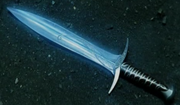
"The blade glows blue when Orcs are close"
In The Hobbit: An Unexpected Journey, Gandalf uncovers the blade on the floor of the cave as he was about to leave and gives it to Bilbo, who is waiting outside. Sting is depicted as vaguely leaf-shaped, with a spiral design and gently curving edges (much like a Greek xiphos), such as Tolkien described in his book. In The Lord of the Rings film trilogy, engraved on the blade are Sindarin letters that read phonetically, Maegnas aen estar nin dagnir in yngyl im. Translated they read, Sting is my name; I am the spider's bane.[5] According to the appendix of The Silmarillion, the element maeg in Sindarin means 'sharp' or 'piercing', and etymologies in The Lost Road and Other Writings give the meaning of the element nass as 'point', so "Maegnas" is literally translated as "sharp-point".
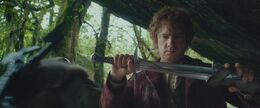
Bilbo holding Sting for the first time after its discovery
In the books there is no mention that Bilbo had the blade inscribed, and the inscription is not present in The Hobbit films, but after Bilbo named the blade Sting he could have had it inscribed by the elves during the story of The Hobbit or after, or the elves could have inscribed it for him after he returned to live in Rivendell. This seems likely since the engraving is in Sindarin and the elves obviously would have had the best experience in reshaping a blade such as Sting.
Despite both Glamdring and Orcrist being elvish blades of similar make, Sting is the only blade shown to glow blue in the The Hobbit and Lord of the Rings films.
Gallery
 |
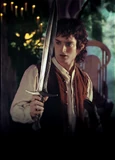 |
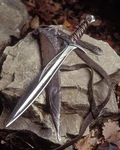 |
 |
 |
 |
 |
 |
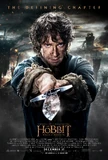 |
Translations
| Foreign Language | Translated name |
| Afrikaans | Stank |
| Albanian | Djeg |
| Amharic | ነደፈ |
| Arabic | ستينغ |
| Armenian | մազմզուկ |
| Azerbaijani | Dişlək |
| Belarusian Cyrillic | Джала |
| Bengali | হুল |
| Bosnian | Ubod |
| Bulgarian Cyrillic | Стинг |
| Cambodian | ទ្រនិច |
| Catalan | Picada |
| Cebuano | Mopaak |
| Chichewa | Mbola |
| Chinese (Hong Kong) | 刺針 |
| Chinese (Mandarin) | 刺叮 |
| Croatian | Žalac |
| Czech | Žihadlo |
| Danish | Stik |
| Dutch | Prik |
| Esperanto | Pikilon |
| Estonian | Nõelamine |
| Filipino | Sigid |
| Finnish | Piikki |
| French | Dard |
| Frisian | Stekke |
| German | Stich |
| Georgian | ნესტარი |
| Greek | Κεντρί (Kentri) |
| Gujarati | સ્ટિંગ |
| Haitian Creole | Pike |
| Hebrew | עוקץ |
| Hindi | डंक |
| Hmong | Plev |
| Hungarian | Fullánk |
| Icelandic | Stunga |
| Indonesian | Menyengat |
| Italian | Pungolo |
| Japanese | つらぬき丸 |
| Kannada | ಕುಟುಕು |
| Kazakh | Стинг (Cyrillic) Stïng (Latin) |
| Korean | 스팅 |
| Kurdish | Pêvedan (Kurmanji) |
| Kyrgyz Cyrillic | чагып алуу |
| Latin | Stimulus |
| Latvian | Dzēlums |
| Lithuanian | Geluonis |
| Macedonian Cyrillic | Стинг |
| Malaysian | Sengat |
| Malayalam | കുത്ത് |
| Maori | Wero |
| Mongolian Cyrillic | хатгах |
| Nepalese | डंक |
| Norwegian | Brodd |
| Pashto | لیشه |
| Persian | نیش |
| Portuguese | Ferroada (Brazil) Ferrão (Portugal) |
| Polish | Żądło |
| Punjabi | ਸਟਿੰਗ |
| Romanian | Țeapa (Înțepătura) |
| Romansh | Piztgar |
| Russian | Жало |
| Samoan | Tui |
| Sanskrit | ष्तिङ् |
| Serbian | убод (Cyrillic) Ubod (Latin) |
| Sesotho | Motsu |
| Sinhalese | විෂ දළය |
| Shona | Ruma |
| Slovenian | Želo |
| Somalian | Micida |
| Slovak | Bodnutie |
| Spanish (Spain and Latin America) | Dardo |
| Sundanese | Nyeureud |
| Swahili | Nyuki |
| Tajik Cyrillic | газидан |
| Tamil | ஸ்டிங் |
| Telugu | స్టింగ్ |
| Thai | ดาบสติง |
| Turkish | Acı |
| Ukrainian Cyrillic | Стинг |
| Urdu | ڈنک |
| Uzbek | Стинг (Cyrillic) Caqmoq (Latin) |
| Vietnamese | Mũi Đốt |
| Welsh | Golyn |
| Xhosa | Suzela |
| Yiddish | שטעכן |
| Yoruba | Ta |
| Barrow-blades • Sting | |
| Durin's Axe • Orcrist | |
| Grond (battering ram) • Grond (hammer) • Morgul-knife | |
| Aeglos • Anglachel • Anguirel • Angrist • Aranrúth • Belthronding • Dailir • Glamdring • Orcrist • Ringil | |
| Andúril • Dramborleg • Black arrow • Dagmor • Gúthwinë • Gurthang • Herugrim • Narsil • Red Arrow | |
References
- ↑ The Hobbit, Chapter VIII: "Flies And Spiders"
- ↑ The Hobbit, Chapter V: "Riddles in the Dark"
- ↑ The Lord of the Rings, The Fellowship of the Ring, Book Two, Chapter IV: "A Journey in the Dark"
- ↑ The Hobbit, Chapter VIII: "Flies and Spiders"
- ↑ The Lord of the Rings: Weapons and Warfare, "Hobbits", pg. 43
External links
- Replica from BladeCenter.com
